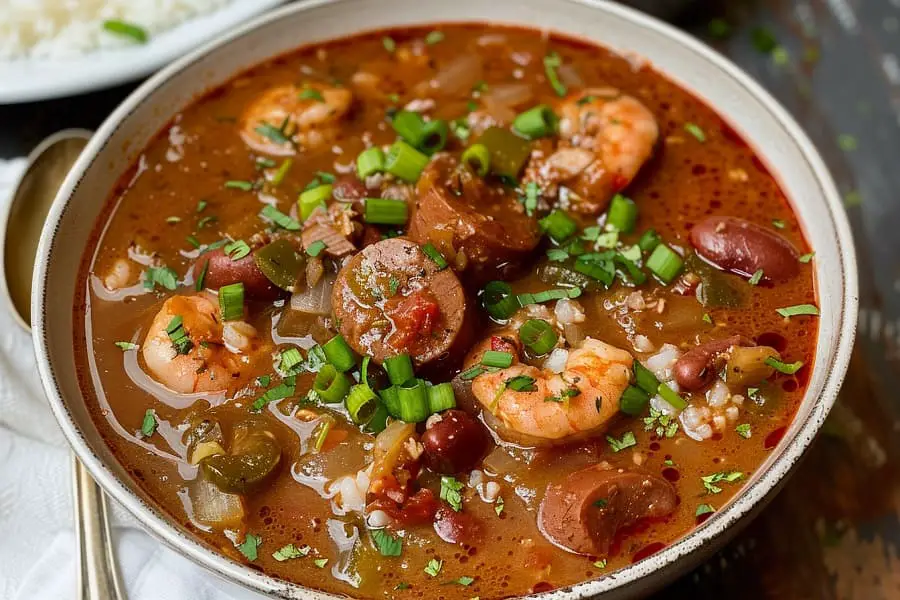Gumbo is a beloved dish that captures the heart and soul of Louisiana’s culinary tradition. However, if you’ve ever wondered what sets Creole gumbo apart from Cajun gumbo, you’re not alone. Both styles are packed with flavor, but they tell different stories through their ingredients and preparation methods. This article will dive into the key differences between Creole and Cajun gumbo, so you can better understand and appreciate these two iconic dishes.
The Key Differences Between Creole and Cajun Gumbo
The primary difference between Creole gumbo and Cajun gumbo lies in their ingredients and the roux they use. Creole gumbo typically features a tomato-based roux and often includes seafood like shrimp, crab, and oysters, reflecting the cuisine’s ties to the coastal city of New Orleans. On the other hand, Cajun gumbo is known for its darker, oil-based roux and usually omits tomatoes, focusing instead on meats like andouille sausage, chicken, and sometimes wild game. The Cajun version has a thicker, stew-like consistency, while Creole gumbo is more soup-like with a complex, refined flavor profile.
The Origins of Creole and Cajun Cuisine
Creole cuisine developed in the multicultural hub of New Orleans, blending French, Spanish, African, Caribbean, and Native American influences. This melting pot of cultures resulted in a diverse, refined cuisine that uses a wide variety of ingredients. In contrast, Cajun cuisine originated with French-speaking Acadian settlers in the rural bayous of Louisiana. Isolated from the city, they adapted their cooking to the local environment, creating a rustic, hearty cuisine that relied on wild game, seafood, and locally grown vegetables.
Ingredients and Flavor Profiles
Creole Gumbo
Creole gumbo is often more soup-like, with a tomato-based broth that adds acidity and sweetness. Common ingredients include shrimp, crab, and oysters, complemented by a butter-based roux that gives the dish a smooth, velvety texture. Herbs like thyme and parsley add complexity to the flavor.
Cajun Gumbo
Cajun gumbo, on the other hand, has a darker, richer appearance, more akin to a stew. The roux, made with oil or lard, is cooked to a deep brown, giving the dish a nutty, robust flavor. Cajun gumbo often includes meats like andouille sausage and chicken, with the “holy trinity” of onions, bell peppers, and celery providing a savory depth.
Cooking Techniques and Preparation
Roux Preparation
The roux is the foundation of any gumbo. Creole roux is typically made with butter, resulting in a lighter, smoother texture, while Cajun roux is made with oil or lard, cooked to a deep brown for a richer, heartier flavor.
Seasoning and Cooking Methods
Creole gumbo is seasoned with a variety of herbs and spices, creating a balanced, aromatic dish. Cajun gumbo is known for its bold, spicy kick, with cayenne pepper and paprika adding warmth. Both gumbos are slow-cooked, allowing the flavors to meld together, but Creole gumbo is more about layering flavors, while Cajun gumbo focuses on creating a hearty, soul-warming dish.
Cultural and Regional Variations
Urban vs. Rural Origins
Creole cuisine, with its roots in the urban environment of New Orleans, had access to a wider variety of ingredients, leading to more refined dishes. Cajun cuisine, developed in rural Louisiana, is more frugal and hearty, using locally available ingredients.
Modern Adaptations
Both Creole and Cajun cuisines have evolved over time, with modern chefs blending elements of both styles. While traditional methods and ingredients remain popular, contemporary versions often incorporate new techniques and ingredients to suit modern tastes.
FAQs
What is the main difference between Creole and Cajun gumbo?
Creole gumbo typically includes tomatoes and seafood, while Cajun gumbo features a darker roux, omits tomatoes, and includes meats like sausage and chicken.
Why doesn’t Cajun gumbo include tomatoes?
Cajun gumbo reflects the rustic, resourceful cooking style of the Cajun people, focusing on the rich flavors of the roux and meats.
Can you mix elements of Creole and Cajun gumbo?
Yes, many recipes today blend elements of both styles, creating unique versions of gumbo.
How long does it take to make gumbo?
Gumbo typically takes 1 to 2 hours to prepare, with the roux being the most time-consuming part.
Is gumbo always spicy?
While Cajun gumbo is known for its spiciness, Creole gumbo tends to be milder, relying more on herbs.
Conclusion
Gumbo is more than just a dish; it’s a culinary expression of Louisiana’s rich cultural history. Whether you prefer the refined flavors of Creole gumbo or the hearty notes of Cajun gumbo, understanding these differences can help you choose the right gumbo for any occasion.
Why not try making both versions and see which one becomes your favorite? They’re perfect for a cozy family lunch or a gathering with friends. Share your experiences in the comments, and follow our blog for more recipes and insights into the flavors of Louisiana and beyond.


1 thought on “What’s the difference between Creole gumbo and Cajun gumbo?”